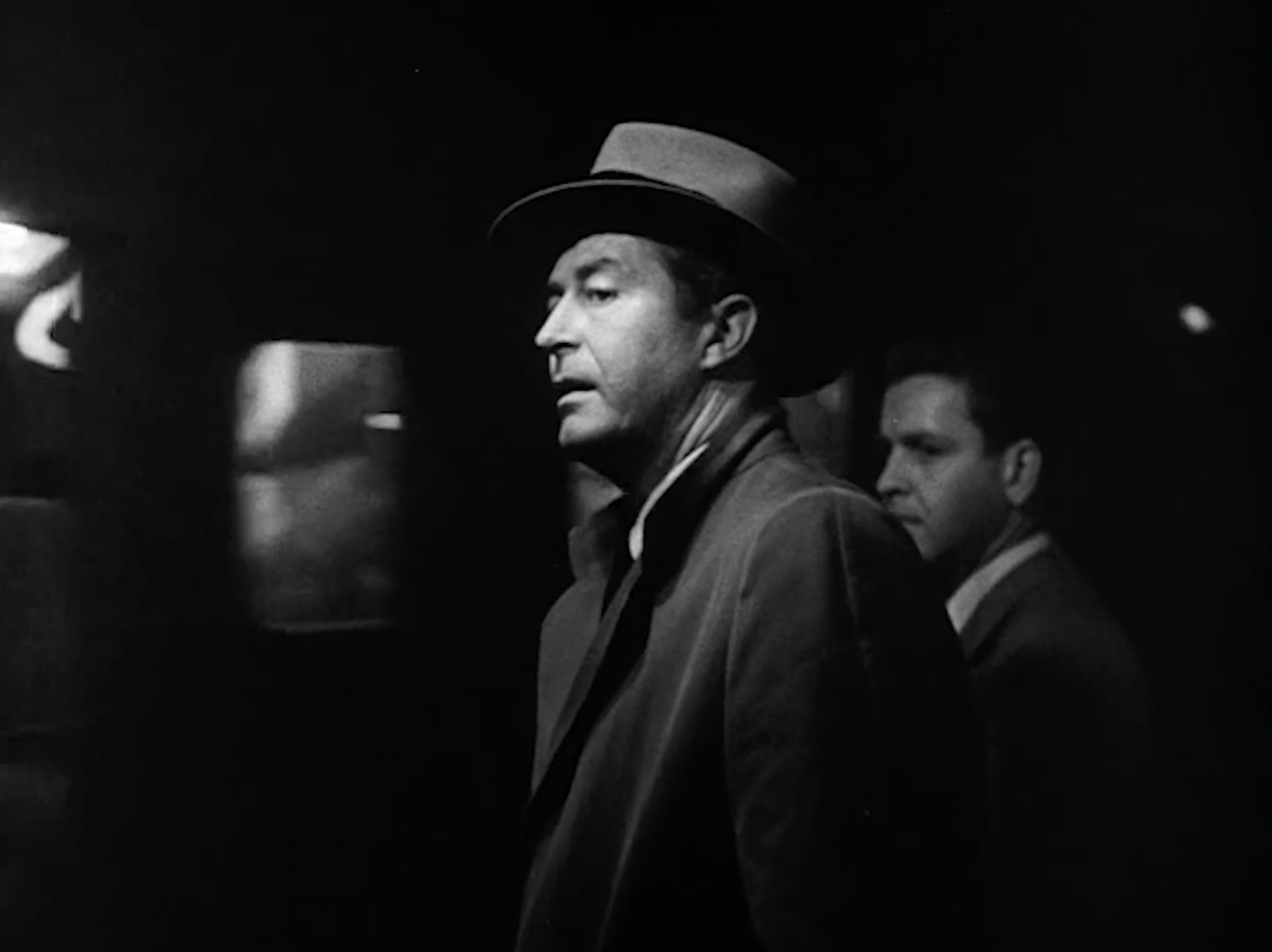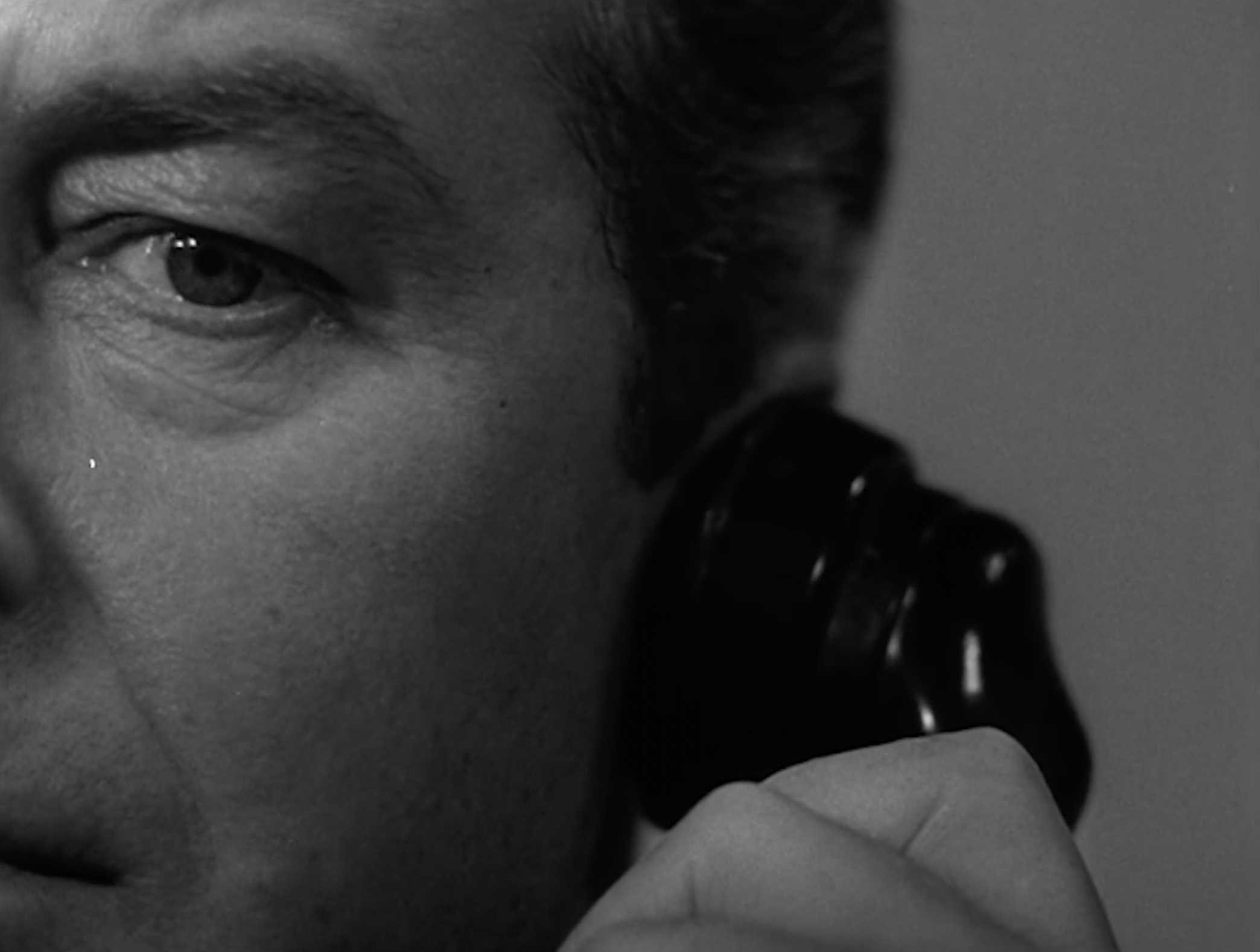Signals in the Dark: Shadows and Silence in The Thief
Detours, episode 9
Signals in the Dark: Shadows and Silence in The Thief
Stephen Broomer, November 14, 2022
A shadow stalks the state capitol. The figure, topped in a fedora, made formless by a trench coat, is not just a harbinger of sedition: he is also at home here, as an embodiment of the secret operations of power. He is the thief of the title, a man who operates in the same silence most of us obey when we’re alone. In a grand symmetry, his shadow here in the film’s opening credits might as well be his shadow in the film’s final moments, his inevitable redemption on the dimly lit steps of an FBI field office. His journey will carry him from ambiguous motives for sedition, to ambiguous motives for redemption. Stephen Broomer presents Russell Rouse's The Thief as a film out-of-time with its era, performing the codes of the silent movie, the large gestures and expressions, anachronistic with both the style of noir and the film's themes of atomic espionage.
SCRIPT:
A shadow stalks the state capitol. The figure, topped in a fedora, made formless by a trench coat, is not just a harbinger of sedition: he is also at home here, as an embodiment of the secret operations of power. He is the thief of the title, a man who operates in the same silence most of us obey when we’re alone. In a grand symmetry, his shadow here in the film’s opening credits might as well be his shadow in the film’s final moments, his inevitable redemption on the dimly lit steps of an FBI field office. His journey will carry him from ambiguous motives for sedition, to ambiguous motives for redemption. The thief is named in the film, though his name isn’t necessary: he is conceived as an archetype, to live out a noir adage, that those who live in the shadows die in the harsh light of revelation. That’s not to say that the thief dies, but rather that film noir offers many kinds of deaths. What most distinguishes this film is its central conceit: for its entire running length, no words will be spoken. The Thief is a silent film, made in America in 1952.
The thief, when revealed by the bright lights of his homey apartment, occupies a haunted existence. Ray Milland’s performance draws from the silent-era style of large, expressive gestures and the heavy countenance of tragedy: all Melpomene, no Thalia. The apartment is a cover from which he sets out for clandestine, codified exchanges, dead drops. His evenings are occupied with waiting and watching and contemplating orders. The thief operates in a ministry of silence. Such silence can be contemplative, or withheld by the bated breath of those who live with a special awareness of terror: civil servants, government agents, scientists, all party to the apocalyptic promise of atomic knowledge. The film is not without language: in fact, language, in the form of top secret American military science is at the very heart of the film’s story. But that is language-as-object, elusive, covert, coveted; in a few rare instances, language is also exposition, in telegrams, in inscriptions. These details betray some of the ambiguity that comes with silence, enough that the film’s Cold War particulars become definite: the thief is a military scientist and he’s giving American secrets to a foreign power. Francis Bacon’s maxim that knowledge is power declares the empowerment of the individual through the growth of a higher awareness; but for many living through the Cold War, knowledge was a form of powerlessness. The Thief has the power to sell secrets, but he lives in a syndicate of interconnected knowledge that brings with it futility, the splitting of the atom, dispassionate annihilation at the press of a button, the war that can’t be won.
The Thief was made by Russell Rouse, who, along with his writing partner Clarence Greene, had been responsible for the narratologically complex screenplay for Rudolph Maté’s D.O.A., which came with the clever framing device of being a story told by a dead man. Released only months before Sunset Boulevard, D.O.A.’s protagonist Frank Bigelow is a less mystical Joe Gillis, telling his tale not from beyond the grave but on the cusp of it, poisoned, reporting his own murder in a police station. It may have anticipated Sunset Boulevard, but D.O.A. also followed on a template of doomed narrators most prominently characterized in another Billy Wilder film, Double Indemnity, in which Walter Neff bleeds out while confessing into a dictaphone. Rouse and Greene’s interest in the unreliable narrator regresses through the gimmickry of The Thief: it is a film that not only calls back to silent era aesthetics, it dispenses with the seeds of doubt that motive provides. The thief cannot plead his own case; without dialogue he has no means of lying to us. His reasons for sedition are never stated. His regret is broadcast by Milland’s grief-stricken stares, but whether he was brought to this point by greed, blackmail, or ideology, he will never try to convince the audience of his justifications, or offer up reasons for his self-loathing or his poisoned, paranoid perception of his environment. The film offers in place a fantasy for those who know shadows by the bureaucracies they keep, and without dialogue, the viewer can only project their suspicions onto Milland’s tortured expressions.
Is the form of The Thief gimmickry? Are its aesthetics regressive? Rouse is using silence to embrace a kind of naturalism, like the silent gaps that define lived experience. The result is not naturalistic, but high stylization, and nostalgia, for a cinema without spoken dialogue that was reliant on expressive faces and expressive movements. It is an alien thing, to encounter the acting style of the silent movie transplanted from the proscenium to the bent perspectives, low angles, and real locations of noir. The Thief does offer some proofs about dialogue and cinema; for one, it is evidence of the ease with which stories are communicated visually, that dialogue becomes merely decorative; but further to that, it is evidence that a lapse into silent-era storytelling brings with it codes, gestures, countenances that are both anachronistic and oneiric. The Thief has the atmosphere of a dream in which things said seldom weather sunrise, while the images of a nightmare can linger as if set in stone.
Once the thief is exposed, the remainder of the film finds him wary, in New York, looking over his shoulder, increasingly trapped in the role of a wanderer, a man without a country. It suggests how many, by trauma, circumstance, bad and desperate decisions, found themselves in that state in 1950s America. He takes to the road to escape the authorities, but his handlers lead him into another kind of prison, a flophouse where he paces and waits, a reminder of how closely the film’s silence resembles the sensory deprivation of solitary confinement. The woman down the hall from him takes advantage of the film’s repudiation of dialogue to create a pure exchange, of eroticism, of unfulfilled longing, ultimately stunted. Like all things in the thief’s life, theirs is a confusion of signals.
The film’s climax finds the thief pursued to the spire of the Empire State Building by a lone federal agent. The thief inadvertently causes the agent’s death, pushing him down the spire, leading to his lone utterance, an agonized wail. He flees the scene of the crime, into a landscape of automats, all-night-diners, reminders of the great things of America: baseball and billiards and neon nights. Far from the gas-soaked main, the thief finds himself down at the docks, boarding a ship for parts unknown. Turning back, he finds something like redemption. A year later, Julius and Ethel Rosenberg would be executed by electric chair, and in hindsight, the thief’s redemption is less the gentle touch of the church confessional and more an act of suicide. Wheeler Winston Dixon has observed that it isn’t so much patriotism that guides the thief to turn himself in, but exhaustion; Milland wears that exhaustion—to use Dixon’s phrase, that spiritual agony—but turning himself in to the feds is something like a patriotic gesture, if not on his part, then on the part of the filmmakers: America, even for the down and out, still represents the best of all possible worlds, or in the case of the thief’s likely fate, the best of all possible damnations.
In Robert Miklitsch’s The Red and the Black: American Film Noir in the 1950s, Miklitsch argues that The Thief is a film about an Other: the single man, who Miklitsch interprets as a blackmailed homosexual, despite or perhaps because of the undercurrent of sexual torment that he encounters in the boarding house. This is a scenario one imagines being common enough to the statehouses of McCarthy-era Washington. I would argue counter to this that The Thief needs no assignation of motive; that he is both Other and Everyman, that in dispensing with dialogue, the film makes him a blank canvas onto which the viewer can project their own judgments and sympathies. This means that he can be a blackmailed gay man, he can be a communist ideologue who is lapsing into disillusionment and self-loathing, he can simply be someone who willingly traded his country for money. He could be a scientist who has become disillusioned for other reasons, as well, like the slow death of civilians in Hiroshima and Nagasaki after the bomb dropped. He could be a pathological thief. He could be a victim of opportunity. He could be just like you. Whatever’s led the thief to his present state, his motives mean little next to the film’s romantic reflection of his grief, weeping over a corpse in the darkened spire of the Empire State Building, or touring his dark night of the soul in the Bowery. The Thief is a work of half-glimpsed signals in dark corners. It lives in the memory of the bomb, in the silence caused by that deafening burst, in the shadows cast by that impossible brightness.







